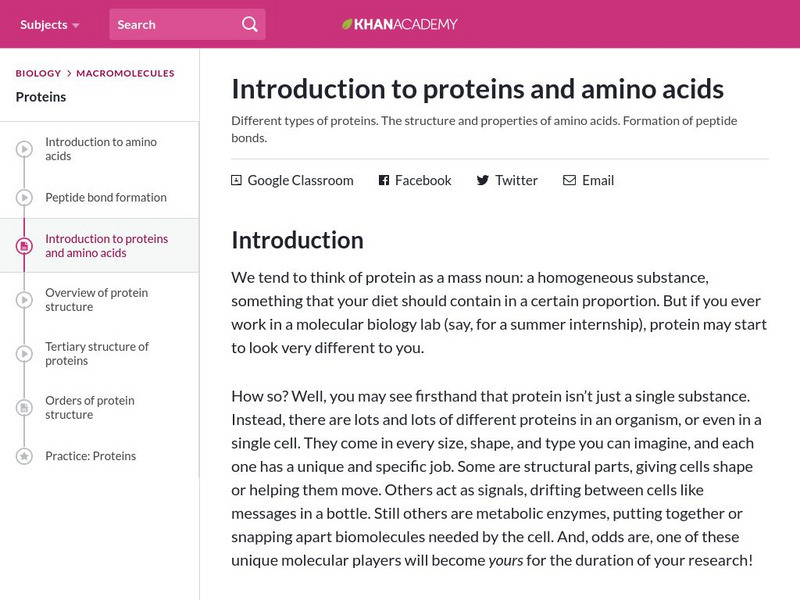Hi, what do you want to do?
Curated OER
Why Do We Need Vitamin C in Our Diet?
High schoolers compare/contrast the DNA sequence data of the rat GULO gene to the inactive human GULO gene. They translate and align the sequences, and propose a scenario to explain the occurrence of an inactive DNA sequence to that of...
Curated OER
Enzymes in Action: An Inquiry Approach to the Effects of Enzymes
Learners experiment with enzymes as key components of chemical reactions in all living things through this series of lessons.
Curated OER
PICKING PEANUTS
Students create sentences, using words printed on pictures of peanuts. They are explained that the peanut is not really a nut, but a legume, related to beans and peas. Students are also told that the first peanuts grew in Brazil. They...
Curated OER
Endocrine System
In this endocrine system worksheet, students compare and contrast the glands associated with this body system plus review the four major classes of hormones. This worksheet has 25 fill in the blank statements.
Curated OER
A TOUGH NUT TO CRACK
Based on a set of criteria, students will evaluate the quality of pecans.1. Bring a gram scale and papershell pecans. Provide five pecans for each student. 2. Divide the class into groups of five and provide each member with five pecans....
Curated OER
Build a Burger
Students read about hamburgers and analyze a healthy diet as well as the importance of nutrition. In this nutrition education lesson plan, students read the background information about hamburgers and their nutrition facts. Students...
Curated OER
Thermoset Polymers
Students complete a lab activity with polymers to allow them to better understand how to make "observations". In this science lesson students make measurements and collect data.
Khan Academy
Khan Academy: Biology: Macromolecules: Introduction to Proteins and Amino Acids
Learn the basics of peptide bonds and how different amino acids combine to form different proteins. Also discussed is the difference in function and structure of proteins.
Encyclopedia of Earth
Encyclopedia of Earth: Evolutionary Biology: Amino Acid
A discussion of the structure and types of amino acids, and of how they combine to form proteins. (Published: October 16, 2010)
CK-12 Foundation
Ck 12: Amino Acids and Proteins
[Free Registration/Login may be required to access all resource tools.] In this module, students investigate amino acids, peptide bonds, and proteins. They also have the opportnity to discover the effect of an enzyme on a biochemical...
National Institutes of Health
Ncbi: Amino Acids Are Linked by Peptide Bonds to Form Polypeptide Chains
Proteins are linear polymers formed by linking the a-carboxyl group of one amino acid to the a-amino group of another amino acid with a peptide bond. The formation of a dipeptide from two amino acids is accompanied by the loss of a water...
Utah Education Network
Uen: Amino Acids
Lesson explores scientific principles in using eggs as a highly nutritious and versatile food source of protein.
Other
Institute of Chemistry: Amino Acids
Clickable list of links to descriptions and models of 20 amino acids, including classification and structure.
University of Arizona
The Biology Project: The Chemistry of Amino Acids
A great site for understanding Amino Acids, the building blocks for protein. Besides a very complete summary, the site includes a complete list of amino acids, a link to basic amino acid structure, a list if atoms in amino acids, and...
Other
Virtual Chembook: Characteristics and Properties of Amino Acids
Each amino acid has at least one amine and one acid functional group as the name implies. The different properties result from variations in the structures of different R groups. The R group is often referred to as the amino acid side...
Chem4kids
Chem4 Kids: Twenty Amino Acids
Humans need amino acids to exist. Click on each of the necessary twenty listed to see their molecular structures and learn what type they are.
National Health Museum
Nhm: Amino Acid Sequences Show Evolution
This lesson plan focuses on differences in the amino acid sequence of hemoglobin and myoglobin proteins. They use the number of differences to create a phylogenetic tree.
Chiral Publishing
Chiral Publishing: An Introduction to Chemistry: Molecular Structures: Amino Acids
View 4 common amino acids from all angles with these 3-D interactive molecules. Also, find links to information about other structures.
University of Arizona
The Biology Project: Immunology: Introduction to Western Blot Activity
Simulate the Western blotting procedure used to identify specific amino-acid sequences in proteins.
Khan Academy
Khan Academy: The Structure and Function of Globular Proteins
The structure of a machine's parts in relation to one another and the proper functioning of the machine itself, applies not just to the machines is, but also to the ones at work inside our bodies. These molecular machines, called...
Vision Learning
Visionlearning: Biological Molecules: Fats and Proteins
An explanation of the importance of fats and proteins in the human diet. Examples of chemical structures of various fats and proteins are used.
Science Buddies
Science Buddies: Solubility of Proteins
Some proteins are soluble in aqueous solutions and some are not. Insoluble proteins can be a problem because the proteins can form large aggregates in solution which are difficult to purify, crystallize, and use in experiments. Compare...

























